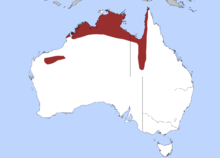Olive python
| Olive python | ||||||||||||
|---|---|---|---|---|---|---|---|---|---|---|---|---|

Olive python ( Liasis olivaceus ) |
||||||||||||
| Systematics | ||||||||||||
|
||||||||||||
| Scientific name | ||||||||||||
| Liasis olivaceus | ||||||||||||
| Gray , 1842 |
The olive python ( Liasis olivaceus ), also known as the olive-colored python , is a species of snake from the python family .
features
The olive python reaches a length of 2 m, rarely up to 4 meters. The elongated arrow-shaped head is clearly set off from the neck. The back and flanks are dark olive to olive brown with an often darker back and cream-colored lips and belly. The subspecies L. o. Barroni is generally larger than the nominate form L. o. Olivaceus , and has fewer dorsal scales and more ventral shields .
Scaling: The frontal shield is large. There is a supraocular shield and an internasal shield on each head side . A pair of large and a pair of small prefrontal shields are separated by a small shield. One, rarely two pre- and three to four post-eyepiece shields are present. The supralabial shields , of which the first two have sensory pits and the fifth and sixth or the sixth and seventh touch the edge of the eye, count from 12 to 15. The infralabial shields , of which four to seven have sensory pits, count from 18 to 22. The trunk shows in L. olivaceus olivaceus 61 to 72 rows of scales , 321 to 377 ventral shields and 96 to 119 subcaudal shields . In L. olivaceus barroni there are 58 to 63 rows of scales and 374 to 411 ventral shields. The fan shield is undivided.
distribution and habitat
The distribution area of the nominate form extends from the Kimberley to central Queensland in northeast Australia and across the islands off the Kimberley. The species occurs in wet and dry areas and prefers rocky terrain with hiding places. L. o. Barroni is found in the Pilbara region of Western Australia and is considered critically endangered due to habitat loss and threats from feral dogs and cats.
Way of life and reproduction
The olive python is mainly active at night and at dawn and is found mainly on the ground. The prey spectrum includes various vertebrates, which are ambushed from hiding places, often also out of the water.
The mating season falls from June to August, the males seek out the females and carry out ritualized fights over them. The eggs are laid in November, the clutch size is 11 to 40 eggs. The young hatch after about two months.
swell
- Ludwig Trutnau : Non-poisonous snakes, part 1 . 4th edition. Eugen Ulmer GmbH & Co., Stuttgart 2002, ISBN 3-8001-3223-0 .
- Liasis olivaceus barroni Species profile of the Australian government
Web links
- Olive python entry at ITIS
- Liasis olivaceus at www.ozanimals.com
- Liasis olivaceus in The Reptile Database
